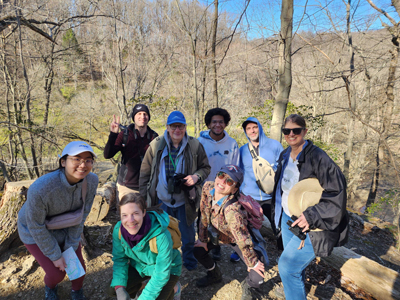Andrew Eberly of the Clifton Institute led a show-and-tell-and-do workshop on the organization’s research into Eastern Box Turtles (Terrapene carolina carolina). The research focuses on what habitats the turtles are using, and what habitats nearby that they give a pass to. Like the kestrel research, one of the goals is to inform landowners about management choices (i.e., when and how to mow). The Institute has numbered more than 100 turtles (there are lots on the 900ac property) with small, harmless notches on the edge of the carapace.

 One aspect of the research is simple mark-recapture, with the collection of various vitals. Andrew is weighing and measuring a turtle that hadn’t been observed on the property before—so it’s a new entry in the database.
One aspect of the research is simple mark-recapture, with the collection of various vitals. Andrew is weighing and measuring a turtle that hadn’t been observed on the property before—so it’s a new entry in the database.

 Certain of the turtles carry radio transmitters (attached with marine glue to the carapace). These turtles are surveyed more regularly. They are relocated with a receiver and antenna (not unlike the gear that I saw in use in North Carolina tracking Piping Plovers). Each turtle is transmitting on a distinct frequency, and the transmitters are good for about 400 days.
Certain of the turtles carry radio transmitters (attached with marine glue to the carapace). These turtles are surveyed more regularly. They are relocated with a receiver and antenna (not unlike the gear that I saw in use in North Carolina tracking Piping Plovers). Each turtle is transmitting on a distinct frequency, and the transmitters are good for about 400 days.
To sample nearby habitat that a turtle isn’t using requires finding a randomly selected point within a 100m radius of where it was found. Bushwhacking required.






























